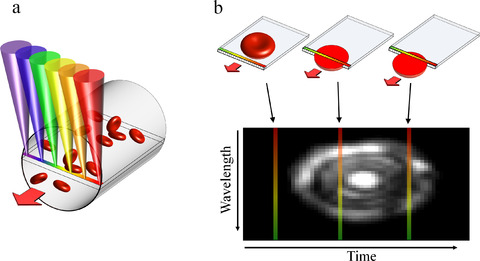
Andor Newton camera powers non-invasive probe capable of providing cell concentration and morphological data.
An Israeli team has demonstrated a non-invasive technique for imaging blood cells in vivo that could eliminate the need to extract blood from many patients.
Powered by the Andor Newton Electron Multiplying EMCCD camera, their high-resolution Spectrally Encoded Flow Cytometry (SEFC) probe offers primary care physicians the capability to detect directly a wide range of common medical disorders.
As well as enabling an immediate medical response to be offered, SEFC could also allow large-scale screening for common blood disorders.
Vitally, its ability to directly and continuously visualise blood cells flowing inside patients could also provide an early warning of a medical emergency, such as internal bleeding, in post-operative and critical-care conditions.
SEFC was developed by the Biomedical Optics Laboratory, headed by Dr. Dvir Yelin, at the Technion-Israel Institute of Technology in Haifa. Their focus is the application of advanced optics to address some of today’s clinical challenges, particularly the development of non- or minimally-invasive diagnostic tools.
According to Lior Golan, one of the researchers at the Biomedical Optics Laboratory, two major challenges needed to be solved. “SEFC Images of fast-moving blood cells are acquired from deep under the surface of the skin through tissue that scatters the light.
“This means that very little light is available and necessitates the use of a spectrometer equipped with a high-speed line camera. The Andor Newton DU970N-BV camera provided our team with a combination of high sensitivity and the required line rate for imaging physiological blood flow.
“Switching between 2-D image and full vertical binning mode on the Newton camera also made the alignment of the spectrometer very easy and the ability to customise the Labview software development kit to control the camera was very convenient.”
Having demonstrated the clinical potential of SEFC, the team believes that miniaturisation of the probe’s optics is feasible to produce a compact, hand-held SEFC probe, free of moving parts and connected to the main system console by just a pair of optical fibers.
This would allow the application of SEFC for minimally invasive applications, either as a standalone device or through the instrument channel of an endoscope.
Andor’s modular Spectroscopy solutions encompass a wide range of high performance CCD, ICCD, EMCCD and InGaAs array detectors, as well as a comprehensive range of Research-grade spectrograph platforms and software development interfaces for Matlab, Labview or Visual Basic.




